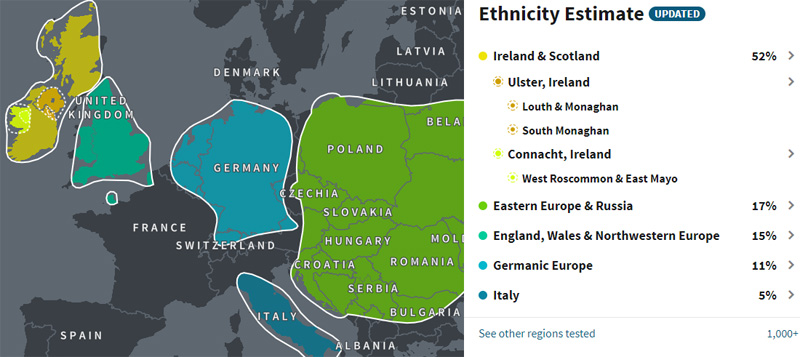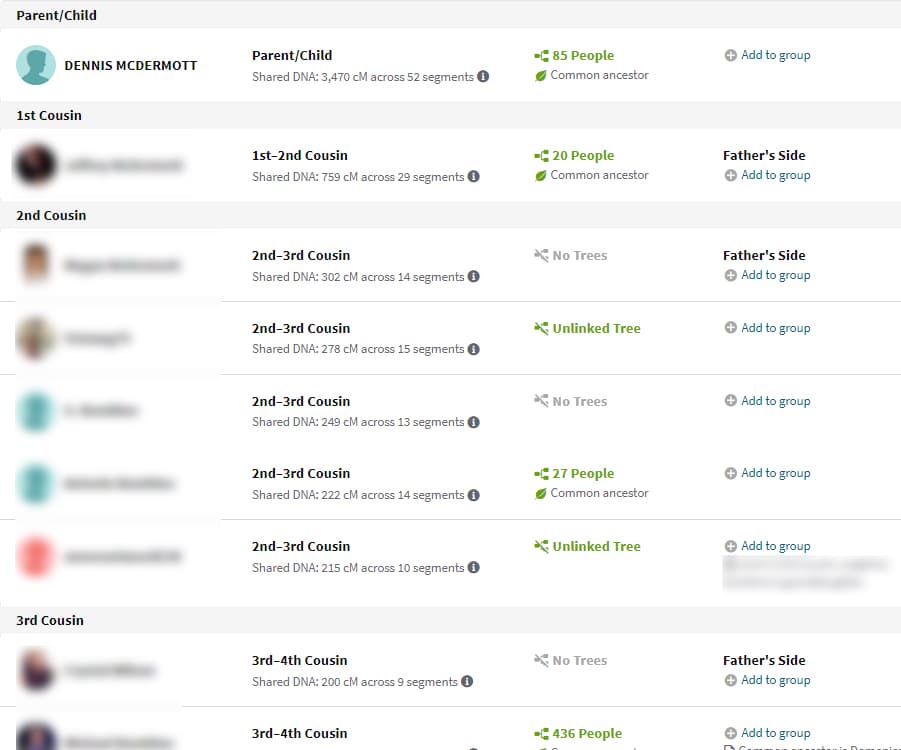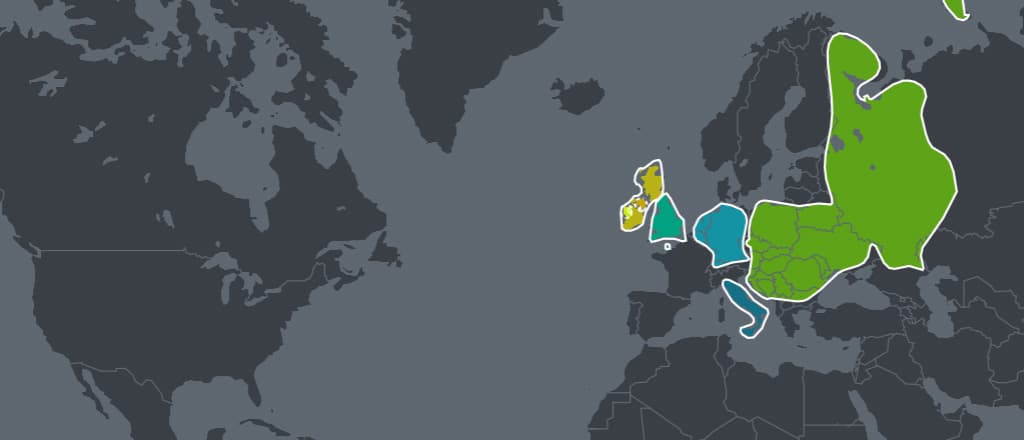AncestryDNA is an autosomal DNA test that provides both ethnicity estimates from 1,500+ regions and family matching from a database of over 20 million customers (see price).
Ancestry tops my list of the best DNA tests. With the largest customer database in the industry, the Ancestry DNA kit is perfect for those doing family history research. Whether you’re looking for your ethnicity breakdown or to connect with distant cousins, AncestryDNA is a fantastic choice.
Prices can fluctuate throughout the year with different promotions, so be sure to check the latest price.
The following is our in-depth AncestryDNA review.
AncestryDNA results
Let’s talk about what you actually get when take a DNA test at Ancestry.
With the standard test, you’re getting a breakdown of your ethnicity as well as a list of DNA matches who you’re related to who have also tested at Ancestry.
Ethnicity estimates
Your ethnicity report will look something like this:

The ethnic region map is interactive so you can zoom in and find additional details such as historic events and migration patterns.
DNA matches
While most AncestryDNA reviews on the web harp on ethnicity results and their accuracy, the true power of Ancestry lies in the shared match report.
Your matches report will look like this:

More on shared matches below.
Traits
When you buy the standard test, you’ll also have the option to add on the traits report.
The AncestryDNA traits report gives you insight into how your DNA might have influenced your physical traits in your appearance, sensories, and others. Ancestry currently tests for None traits.
The traits reports are not particularly useful for genealogy – they’re more of a fun thing to have and share with friends and family.
I will note that the science here is not perfect, but it’s improving. For example, my traits report for male hair loss says I have a low chance of baldness. I started losing my hair by age 20.
AncestryDNA Health
AncestryHealth is a separate product that bundles the standard DNA test with a dedicated health test similar to 23andMe.
The health test looks at different genetic conditions you already have or may have in the future. It will also identify conditions that could potentially be passed down to your children.
It’s important to note that DNA health tests are merely a high-level screening of potential issues that you may want to discuss with your doctor. They are in no way a diagnostic tool.
When and how do I get my test results?
It takes about six to eight weeks after you send the kit to the lab in order for your results to come back. AncestryDNA will send you an email as soon as they are ready. To access your results, you need to log in to the Ancestry website. For more on this, read how long does AncestryDNA take.
Naturally, that means that you must have a valid email address to get the notification and some way to access the website to get your results.
But chances are if you’re reading this, you already have both 🙂
Finding your relatives
One of the biggest advantages of autosomal DNA testing is that it can help you connect with living relatives, including many you never knew existed.
Many of us have family trees that only extend out to our great grandparents and have no clue who our third and fourth cousins are. Yet they are closely related enough that they may be researching the same family lines as you. And DNA testing can help you find them.
AncestryDNA has tested more than 20 million people so far. That’s a huge batch of potential DNA matches.
The only drawback is that you have to opt-in so that others can see your results. So even if your relatives have been tested, you won’t find them unless they allow people to find them.
That means that you really should share your results so your relatives can find you, too.
When you do find a match, you can connect with them by email and start collaborating right away.
If you’re adopted and looking for your birth family, DNA testing is the perfect way to find them and get connected.
You can also link your DNA results directly to your Ancestry family tree which you can create with a free account. The only time you need a paid account is if you want to see someone else’s family tree or access historical records.
AncestryDNA accuracy
Genealogical DNA testing hasn’t been around that long, but it has already come a long way.
Millions of tests have been collected and compared with traditionally researched family trees. With every passing day, the results become more accurate.
They are already good enough that AncestryDNA will break down your ethnicity estimates to intervals of just 0.1%, although this could be considered a low confidence region.
Just keep in mind that genetic information won’t tell you everything. In the past two centuries, people have been moving around more and faster than at any time in history.
So even if you have a good read on where your ancestors originated, that doesn’t mean that they didn’t move two or three times in just one generation.
For more on the accuracy, read this article: Can Ancestry DNA be wrong?
Taking the test
Getting your DNA tested with an AncestryDNA kit is very simple and straightforward.
First, order your DNA kit online. You will also need to set up a basic (free) Ancestry account if you don’t already have one so that you can receive your results.
When you receive the kit, it will contain a saliva sample collection tube and a set of simple instructions for how to fill the tube, package it, and return it with the prepaid postage.
You also need to activate the kit online in order to connect the unique serial number of your kit with your Ancestry account.
That way the testing lab never knows anything about you, not even your name. All they get is an anonymous ID number.
To make sure your test is accurate, you should not eat, drink, smoke, brush your teeth, or chew gum for at least 30 minutes before you take the test.
After you’ve filled the specimen tube with your DNA sample, pack it up according to the directions and mail it back. Your kit will include a prepaid mailing label to ship the kit to the lab for testing.
Ancestry vs. other testing companies
There are many choices for getting testing done, so it’s important to know the pros and cons of each company before choosing one.
The biggest advantage of testing through Ancestry is that you can connect your DNA results to all of the other services that Ancestry offers.
This includes online family trees, billions of genealogical records, and millions of other users.
Ancestry also has the largest customer database of any consumer DNA company which maximizes your DNA matches list.
Ancestry vs. 23andMe
The main advantage of 23andMe is that they offer a better health test than Ancestry. 23andMe’s main focus is health testing whereas Ancestry focuses on family history.
Unlike Ancestry, 23andMe also gives you all three types of tests for a single price (autosomal, mtDNA, Y-DNA for men)
The mtDNA and Y-DNA tests offered by 23andMe only report on a broad haplogroup and does not include any type of matching. It should not be confused with the dedicated mtDNA and Y-DNA offered by companies like FamilyTreeDNA.
Ancestry has a huge online community and billions of searchable records, while 23andMe has neither, making it harder to apply their results to your research. Ancestry is much more focused on family history.
23andMe also does not give you the ability to build a family tree.
See our complete comparison of Ancestry vs 23andMe or our individual review of 23andMe.
Ancestry vs. FamilyTreeDNA
More people have been tested through AncestryDNA than any other company, including FamilyTreeDNA, which means they have a larger database of potential matches.
That means you have a better chance of finding living relatives and fellow researchers based on your results.
Ancestry only offers autosomal DNA testing, while FamilyTreeDNA offers all three tests (purchased separately or in a bundle).
See our full review of Family Tree DNA.
Ancestry vs. MyHeritage DNA
Both sites have a great focus on family history and plenty of records to search. Both companies also only offer autosomal tests, so there’s no advantage either way there.
MyHeritage DNA breaks the world down into more regions, which might help you narrow down your searches a bit more.
However, Ancestry has a much larger database of test results, meaning you have a better chance of finding matches which is critical for family history research.
While Ancestry does have a larger customer database overall, MyHeritage has a larger (and growing) database of international customers. So if you’re in the U.S. and looking for relatives in Europe, you may be more likely to find them at MyHeritage.
Read our complete comparison of MyHeritage vs Ancestry or our individual review of MyHeritage here.
About your DNA
Since we reference different types of DNA tests in this article, let’s take a moment to define what they are and what they can do for you.
- Autosomal: this is by far the most popular test and reports on your ethnicity and family matches. You inherit autosomal DNA equally from both of your parents.
- mtDNA: both males and females get mitochondrial DNA directly from their mother, and she from her mother, and so on back through history in a direct maternal line.
- Y-DNA: only males have a Y-chromosome which they get directly from their father, and he from his father, and so on back through the direct paternal line. Females do not have a Y-chromosome so they cannot take this test.
Autosomal DNA testing is by far the most popular type of test, and the only type currently offered by AncestryDNA.
If you want to take advantage of the other tests, you will need to have them done through another company (see our guide to the best DNA test for ancestry).
However, autosomal DNA is the most useful for genealogy, so if you go with an AncestryDNA kit, you won’t be missing out on a lot.
Y-DNA and mtDNA are typically used for more complex and specific cases in genealogy.
It’s important to understand that autosomal DNA is mixed together in each generation, with a child getting half of his or her autosomal DNA from one parent and half from the other.
That means with each generation you go back, the portion of your DNA from a particular ancestor drops by about half.
So about 1/4 of your autosomal DNA comes from each of your grandparents, about 1/8 from each of your great-grandparents, and so on.
By the time that figure drops to 1/32 or 1/64, it becomes tough to accurately connect people, so autosomal DNA is only useful for five or six generations (sometimes as many as ten, but almost always less).
Still, that means it can help you find a number of living relatives, up to third, fourth, or even sometimes fifth cousins.
What about my privacy?
Ancestry is dedicated to making sure your privacy is protected. Your personal information is never going to be shared with any other company.
Even the testing lab never sees any of your information. The only thing they have for you an anonymous ID number.
It is entirely your decision whether you ever share your results with anyone or not.
Even if you do share your results, the only people who will see them are living relatives, folks whose DNA is a close match to yours.
And those are exactly the people you do want to find.
As far as Ancestry is concerned, your results are entirely your own. You can download your raw results, have them deleted from Ancestry’s system, or even have them destroy your original saliva sample.
“Ancestry does not voluntarily cooperate with law enforcement….[and] …require all government agencies seeking access to Ancestry customers’ data to follow valid legal process and do not allow law enforcement to use Ancestry’s services to investigate crimes or to identify human remains.”
You can read their complete guide to law enforcement policies here.
Raw DNA data
Can I take my raw DNA to other websites?
Yes, as long as those sites let you upload raw DNA data.
You can download your raw data from Ancestry at any time after your results come back.
That means you can take the test once and then get the benefit of several sites, which is always a good idea.
Note that at the moment Ancestry does not allow the upload of raw data from other companies, so you can take your results somewhere else, but you can’t bring results from somewhere else to Ancestry.
How much does all this cost?
The list price for Ancestry’s autosomal test is normally $99. That includes the cost of the kit and the processing at the lab.
Occasionally Ancestry will have a sale on their DNA kits, so be sure to check the website for the latest pricing.
There is an additional shipping fee of around $10, which covers the cost of mailing the kit to you and the pre-paid mailing label to send it to the lab for testing.
In some cases, they may have to charge tax as well, but there’s no way to check if that applies to you until you’ve started your order (but before you actually pay anything).
Once the test has been done, there are no other fees to complete the testing and view results.
You do not need a paid subscription to view your results or build a family tree.
However, to view the family trees of your matches or to access the historical record collections, you do need to have a paid subscription. Click here to see the latest pricing.
Final thoughts
You don’t have to have DNA testing done in order to research your family tree, but without it, you’re missing out on a powerful tool.
And when you consider just how cheap the tests have become, there’s very little reason not to expand your ancestral search with a DNA test.
And with AncestryDNA, you aren’t just getting a basic ethnicity estimate.
You’re getting the chance to connect your DNA to your family tree, to contact family members across the country and around the globe, and the chance to dig through billions of online historical records to flesh out your research.
For more information or to buy a test kit, visit AncestryDNA here.
We hope this AncesetryDNA review was helpful. Questions? Feel free to post in the comments below.
 Marc McDermott
Marc McDermott
